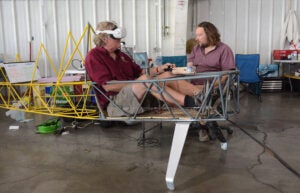
Let’s say you’re trying to introduce the sport of pylon air racing to a new generation. What would be better than a full-size virtual reality simulator?
Semi-retired IT specialist Brian Murray thought so, and combining his mad electronic skills with a Cassutt frame destined for the scrapper put together the prototype simulator seen here. The electronics center around a magic box (an appropriate description for our level of electronic design understanding) that Murray built to integrate the output from potentiometers fitted to the throttle and flight controls. Clearly the output of Murray’s magic box is input to a flight sim program, and voila, anyone sitting in the fuselage and wearing the VR goggles is flying a Cassutt.
A real-world Cassutt racer provided the modeling input and Murray says the result is his simulator precisely replicates the feel and motion of the real thing. For now Murray has Reno’s 3-km course up and running for folks to try in the rear of the Formula 1 hangar at Reno. Of course we would have given it a try except we had a photo assignment, so no pirep this time around other than to say watching others have a go sure made it look like the simulator has captured the Cassutt’s sensitive ways.
Clearly the technology offers important potentials. The Formula 1 class, along with others, is thinking the simulator could make a nifty teaching tool for new race pilots as an instructor can standby and virtually fly with the student. That would be a first in air racing.
For promotion the sim offers equally game changing possibilities once the rig is all dolled up with paint and fabric. Designed to introduce and explain air racing to politicians, airport managers and the like, it could certainly help in that regard. As a sidewalk simulator for the masses it would be a huge ambassador for the sport. Heck, if you had six of them lined up at a major air show you could start your own virtual air racing league. Or at least have a lot of fun.













